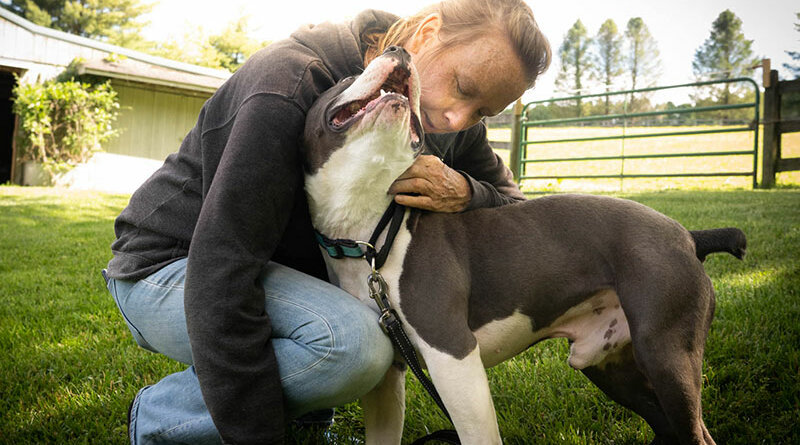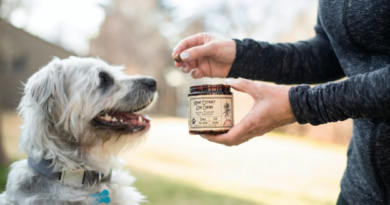Tips on Successful Fostering | The Bark
Cara Sue Achterberg is a prolific writer and an active—some might say hyperactive—dog rescuer. In her latest book, One Hundred Dogs and Counting, she chronicles her experiences fostering more than 175 dogs of all sizes and types. Many of the dogs arrive at her hillside farm in her home state of Pennsylvania from shelters in the Southeast.
These shelters also come in all sizes and types, and as part of her foster work, Achterberg has led visits to a number of them over the years. She volunteers her knowledge and organizational skills to these facilities, which are often underfunded and short of resources despite their staffs’ abundance of goodwill and dedication to saving animals.
In her writing, blogs, podcasts and public appearances, she advocates for rescue dogs. Like a proud pack leader, she personalizes complex and systemic issues, shares the challenges and rewards of fostering, and highlights some of her favorite dogs. Among her other books, Another Good Dog (Pegasus Books 2018) is a companion piece to her new work. In both books, readers will discover a woman of unwavering commitment to animals in need and an advocate for making a difference.
In this discussion, Achterberg shares some expert advice, including how to provide a foster dog with a good experience, her top tip on what to do first when bringing a foster dog into your home, how to engage the community in successful rescue/foster activities, and five things she’d mandate if she could make the rules governing animal welfare—particularly dogs’ welfare.
Bark: What type of person tends to be successful at fostering dogs?
GET THE BARK IN YOUR INBOX!
Sign up for our newsletter and stay in the know.
Cara Sue Achterberg: I suppose that depends on the purpose of the fostering situation. Some shelters have “foster to adopt” programs, where the successful foster ultimately adopts the dog. Those of us in the rescue world call ourselves a “foster fail” when we choose to adopt the dog we are fostering. Hospice fostering is completely different from fostering an adult dog or a litter of puppies for a shelter or rescue. In terms of fostering for a shelter or rescue, the type of person who is successful varies widely, but I believe they have to approach fostering as a job to do. A foster’s job is to prepare a dog to be adopted. Some dogs need time, space, patience. Others need exercise, engagement, direction. They all need routine, safety and security. Many times, the dog you pick up from a transport or a shelter is very different from the dog living in your house a week later. Shelter dogs are stressed to the max, and their reactions can vary from completely shutting down to aggressively reacting to every stimulus.
If I had to assign characteristics of a good foster, it would be patient, kind and motivated to help a dog. The rest you can learn. How to help shy dogs, reactive dogs, dogs who have only lived outdoors, dog who have health issues—all of that, a good rescue group or shelter can teach you how to handle. The vast majority of dogs being placed in foster situations are simply good dogs that require no special skills, only the willingness to love a dog.
B: Fostering dogs with problematic behaviors seems daunting. While these behaviors are absolutely understandable, it must be stressful for those doing the fostering. Have you found some strategies to be more successful than others in dealing with both the behaviors and the stress?
CSA: A lot of times, you don’t know a dog has problematic behaviors until you’ve had him home a week or two. I’ve fostered over 175 dogs now and I’ve only had a two or three with truly problematic behaviors, and those behaviors were all manageable—even Gala (the dog I wrote so much about in One Hundred Dogs and Counting) was not dangerous; she just needed our family to sort out how to manage life with her. Our busy house was not a good fit, and if I had it to do over, I would have worked harder to move her sooner than we did. That said, she taught me a lot.
When you bring home a new foster dog, the first thing you need to do is what our rescue calls a “shut-down.” The dog needs a quiet place, usually a crate (for some dogs, it can be a small room) where he can relax and recover from living in a shelter and/or being abandoned and the stressful transport that brought him to us. This means providing a comfy bed, a few toys, regular meals, water and calm walks. Giving a dog a few days, or a few weeks, if necessary, to reset is critical.
I also find that gates, crates and regular exercise go a long way toward managing a challenging dog. The challenging dogs I’ve encountered have all been very smart dogs who need plenty of engagement. I get them out for long daily walks; play fetch until my arms give out; and, with one particularly busy, nipping dog, I trained her for agility.
Instead of focusing on what is “wrong” with the dog (because a personality trait is not a fault), find what the dog can succeed at, what he likes to do, and how you can help him shine. That will be the best way to attract the perfect adopter for that dog.
Fostering is never boring—you learn something from every dog you encounter. While the challenging ones get all the press, foster dogs bring far more joy to our household than hardship. Rescue dogs have a sense of gratitude about them, and they are literal lessons in forgiveness and unconditional love.
B: How hard/practical would it be to implement the strategies in play at South Carolina’s Anderson County PAWS nationwide?
CSA: Not hard at all—providing you have a workable shelter and motivated leadership. The PAWS staff meets weekly to come up with more ideas to help their animals find homes. Everyone, not just the director, has a voice and a stake in this. They try all kinds of programs, smart management, fundraising ideas and training to be sure they are improving all the time. They engage their community; partner with rescues; practice smart, preventive veterinary care; cultivate a strong volunteer program; and work to reduce barriers to adoption. In addition, they counsel potential owner-surrenders to help them keep their pet in their home. Very little of that costs money, but all of it requires motivated leadership.
The reason we can’t put PAWS practices into place everywhere is because too many states have no real sheltering system. In western Tennessee, they still operate with a dog-pound system where dog-catchers (who are not trained animal professionals) contain dogs in rudimentary conditions for their stray hold (three to five days) before destroying them or having a local vet do it for them. In Mississippi, there are very few, if any, truly public shelters; instead, they depend on a patchwork of nonprofit rescues and shelters. In Alabama, it is the state law that every county have a shelter (they call it a pound) or pay their portion to a neighboring county for those services, but at least half of the counties are out of compliance.
In order to put progressive practices in place that will save every adoptable dog, there must be a shelter-building and motivated leadership. Without those two key pieces, it’s hard (but not impossible) to save lives.
B: What would make dogs’ lives better, and/or improve our animal-welfare system overall? If you could make five rules that everyone had to follow, what would they be?
CSA: Dogs’ lives would be better overall if everyone, including governments, valued dogs’ lives and understood that we have a responsibility we incurred when we domesticated them to protect those lives, and to shelter them when necessary until every dog has a home.
And gosh, I sure would love to set the “rules.” If I did, here’s what I’d propose:
Rule 1: Remember that every dog is an individual and stop labeling shelter dogs as any particular breed. Research makes it clear that breed assignment is wildly inaccurate, even when done by professional shelter staff. In some places, labeling a dog a “Pit Bull” can increase or even guarantee the dog’s death, while labeling him something else—say, a Labrador Retriever—can mean he gets rescued. Whatever the label, it still carries with it unrealistic expectations that can lead to the dog’s return and ultimate death. Even within purebreds, every dog is different. So, basically, if you don’t personally know the parents or you haven’t done a DNA test, do not label the dog anything beyond “dog.” If you must label him something, label him a “medium-sized, energetic dog” or a “large, friendly dog” or a “small, long-haired dog.”
Rule 2: Every county in every state must maintain an animal shelter (or pay its share for a shelter shared amongst counties) in which animals are housed and fed humanely and given proper veterinary care, including vaccinations, spay/neuter, and heartworm testing/preventives.
Rule 3: Every community must pay for its animal control department with tax dollars. We domesticated dogs (and cats), and it is our responsibility to be sure they are cared for so that they don’t endanger the public, spread disease or become a nuisance. That said, a good shelter will need very little tax money once it’s established. Adoption fees, community programs and the shrinking number of animals within (thanks to community education, spay/neuter and foster programs) will see to that.
Rule 4: Every county-funded shelter must offer community education; low-cost/no-cost veterinary clinics; and a volunteer program that includes a foster program, animal-enrichment programs and community service opportunities.
Rule 5: In order to graduate from high school, every student must complete some form of safe dog interaction education. Too many animals end up in shelters because of a bite that could have been prevented if people knew how to safely, respectfully interact with dogs.
Read our review of “One Hundred Dogs and Counting.”
For an excerpt from “One Hundred Dogs and Counting.”





cost of augmentin